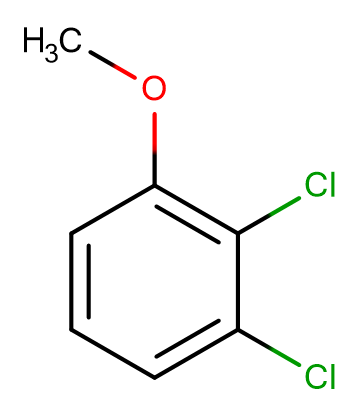
2,3-Dichloroanisole
CAS No. 1984-59-4
2,3-Dichloroanisole( —— )
Catalog No. M13096 CAS No. 1984-59-4
Substituted aminosalicylic acid amides with fungicidal effect and intermediate products.
Purity : >98% (HPLC)
 COA
COA
 Datasheet
Datasheet
 HNMR
HNMR
 HPLC
HPLC
 MSDS
MSDS
 Handing Instructions
Handing Instructions
| Size | Price / USD | Stock | Quantity |
| 5MG | 37 | In Stock |


|
| 10MG | 45 | In Stock |


|
| 25MG | 61 | In Stock |


|
| 50MG | 98 | In Stock |


|
| 100MG | 129 | In Stock |


|
| 200MG | 181 | In Stock |


|
| 500MG | Get Quote | In Stock |


|
| 1G | Get Quote | In Stock |


|
Biological Information
-
Product Name2,3-Dichloroanisole
-
NoteResearch use only, not for human use.
-
Brief DescriptionSubstituted aminosalicylic acid amides with fungicidal effect and intermediate products.
-
DescriptionSubstituted aminosalicylic acid amides with fungicidal effect and intermediate.
-
In Vitro——
-
In Vivo——
-
Synonyms——
-
PathwayOthers
-
TargetOther Targets
-
RecptorOthers
-
Research Area——
-
Indication——
Chemical Information
-
CAS Number1984-59-4
-
Formula Weight177.03
-
Molecular FormulaC7H6Cl2O
-
Purity>98% (HPLC)
-
SolubilityLimited solubility
-
SMILESCOC1=C(Cl)C(Cl)=CC=C1
-
Chemical Name——
Shipping & Storage Information
-
Storage(-20℃)
-
ShippingWith Ice Pack
-
Stability≥ 2 years
Reference
1.Ramu L, et al. Magn Reson Chem. 2010 Aug;48(8):593-9.
molnova catalog



related products
-
Cancer-Targeting Com...
Cancer-Targeting Compound 1 can be used in the study of hormone-related cancers, including the treatment or prevention of fibroids, uterine leiomyomas, polycystic ovarian syndrome, or hormone-dependent Cancer, among others.
-
Apigenin 6-C-alpha-L...
Apigenin 6-C-alpha-L-arabinopyranosyl-8-C-beta-D-xylopyranoside is a natural product from Viola yedoensis.
-
alphaSYN-IN-NAB2
alphaSYN-IN-NAB2, a neuron-protective agent, is a protein encoded by the NAB2 gene. NAB2 effectively and selectively protects a variety of cells from alpha-SYN toxicity.



 Cart
Cart
 sales@molnova.com
sales@molnova.com


